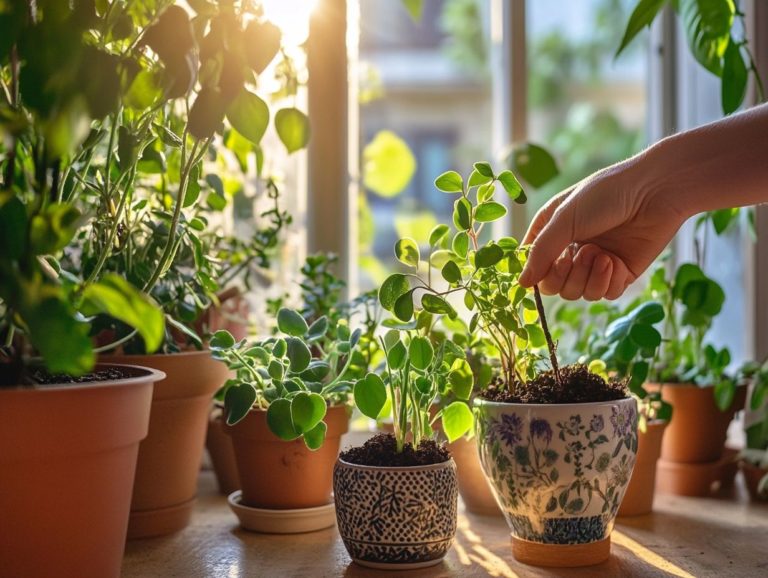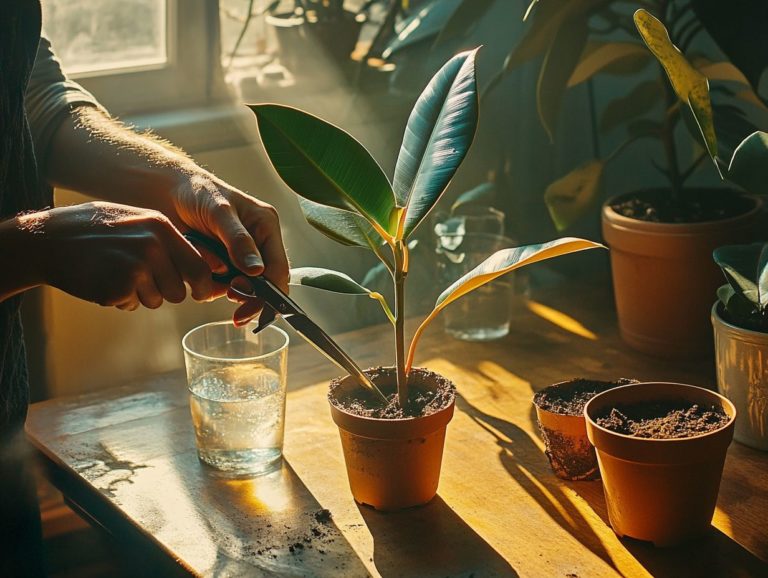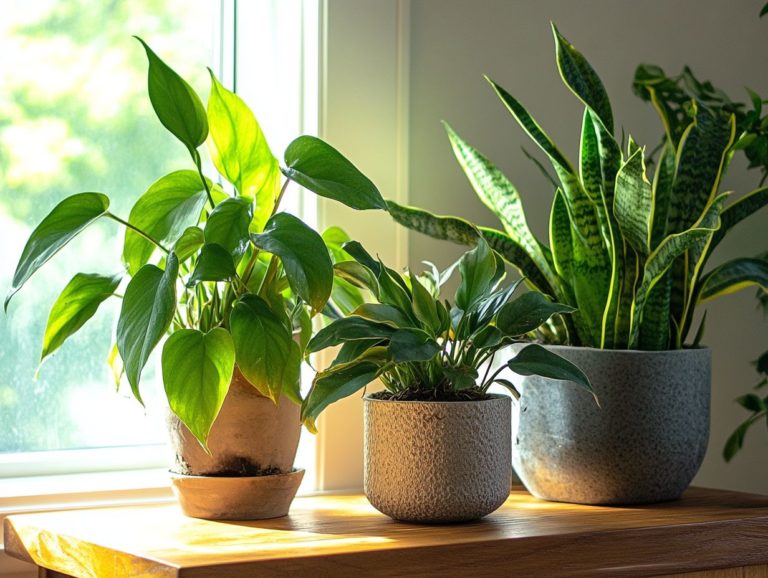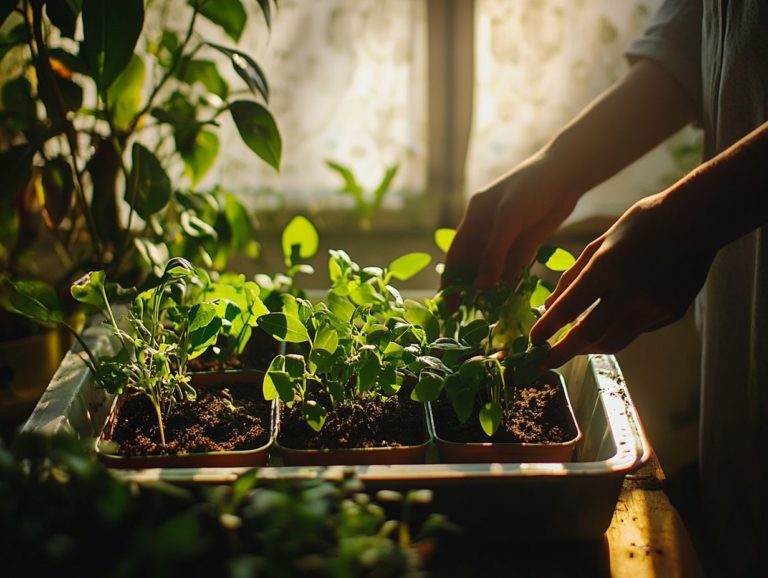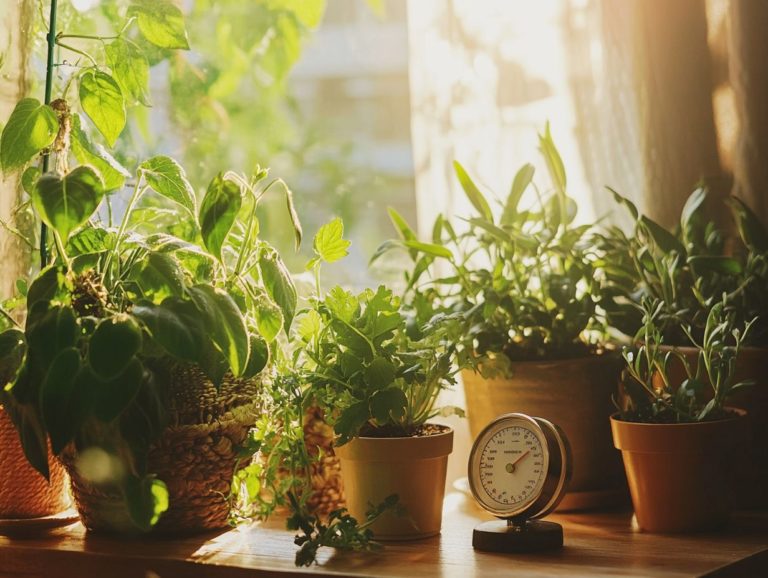A Comprehensive Guide to Indoor Plant Propagation
Indoor plant propagation is a cost-saving and fulfilling endeavor that enables you to expand your houseplant collection while keeping your budget intact.
Whether you’re a seasoned gardener or just starting out, understanding the various methods like seed propagation, cuttings, and division can truly elevate your experience.
This guide is designed to cover the essentials, from selecting the right plant varieties and gathering your gardening supplies to providing plant care tips for your new green companions. You ll also find insights into the common challenges you might encounter along the way.
Get ready to bring new life into your home and enjoy the beauty of plants!
Contents
- Key Takeaways:
- What is Plant Propagation?
- Methods of Indoor Plant Propagation
- Choosing the Right Plants for Propagation
- Supplies and Tools Needed for Indoor Plant Propagation
- Step-by-Step Guide to Indoor Plant Propagation
- Troubleshooting Common Issues
- Frequently Asked Questions
- What is indoor plant propagation, and why is it important?
- What are the benefits of propagating indoor plants?
- What are the essential tools and materials needed for indoor plant propagation?
- What are the different methods of indoor plant propagation?
- How can I ensure successful indoor plant propagation?
- What are some common mistakes to avoid when propagating indoor plants?
Key Takeaways:

- Indoor plant propagation lets you grow new plants from the ones you already have!
- Some common methods of indoor plant propagation include seed, cuttings, and division.
- To successfully propagate plants, choose the right species, have the necessary supplies, and follow a step-by-step guide.
What is Plant Propagation?
Plant propagation is an enchanting journey of creating new plants from existing ones. It allows you to expand your indoor jungle while experiencing the joy of nurturing new life.
This rewarding adventure involves various methods, such as cutting techniques, soil rooting, and water rooting. Not only is it a creative endeavor, but it’s also a budget-friendly way for you to grow your houseplant collection.
The art of propagation deepens your connection with nature, providing a fulfilling sense of accomplishment as you watch those tiny roots emerge and flourish. Each propagation method offers its own unique thrill; for instance, the anticipation of watching a cutting develop roots in water can spark delightful excitement.
Sowing seeds in soil brings the promise of future blooms to cherish. This exciting practice helps you quickly cultivate a vibrant array of greenery!
By sharing cuttings with friends or family, you can elevate the propagation experience, fostering relationships and creating a vibrant community among fellow plant enthusiasts.
Methods of Indoor Plant Propagation
Understanding the art of indoor plant propagation can elevate your gardening prowess, allowing you to cultivate an impressive array of houseplants, from Monstera Albo to Fiddle Leaf Fig.
Each technique, whether it’s seed propagation, cuttings, or division, presents its own distinct advantages and challenges, catering to various plant enthusiasts and their aspirations for a thriving green space. To learn more about the best time to propagate your indoor plants, embrace these methods, and watch your indoor garden flourish in ways you never imagined.
Seed Propagation
Seed propagation stands as a cornerstone of gardening, allowing you to grow seeds and nurture new plants. It’s an excellent way for you to hone your skills and cultivate robust roots.
To achieve success with this technique, you’ll need to master proper soil rooting strategies and gather the right gardening supplies. First and foremost, selecting high-quality seeds is paramount; the germination rate hinges on this crucial choice.
After you’ve picked your seeds, focus on preparing the soil. Ensure it s rich in nutrients and has excellent drainage to foster robust root health. A well-aerated soil mix will set the stage for optimal growth.
During the germination phase, maintaining consistent moisture and the right temperature is essential, along with providing sufficient light once your seedlings start to emerge.
Be cautious about overwatering, as this means the roots of your plants are decaying due to too much water a gardener s nightmare. By prioritizing these key elements and nurturing your plants with care, you can cultivate strong, healthy roots that support the overall vitality and flourishing of your new botanical companions.
Start your propagation adventure today and watch your indoor garden thrive!
Cuttings Propagation
Cuttings propagation is an effective way to grow new plants from existing ones. You can do this by taking stem or leaf cuttings and nurturing them until they develop roots. Tools like a cutting knife and rooting hormone can give your cuttings a boost, encouraging faster root development.
To get started, select healthy stems with several small bumps on stems that grow roots, as these are vital for root formation. If you spot aerial roots, keeping them intact can enhance your chances of successful rooting.
Once you’ve chosen your cuttings, place them in a suitable growth container that provides both adequate drainage and moisture retention. A lightweight soil mix is recommended for proper air circulation around the roots.
After planting, maintain a warm, humid environment for your cuttings and monitor moisture levels closely. Regular misting or using a clear plastic cover can help sustain humidity, creating optimal growth conditions for strong, healthy roots.
Division Propagation
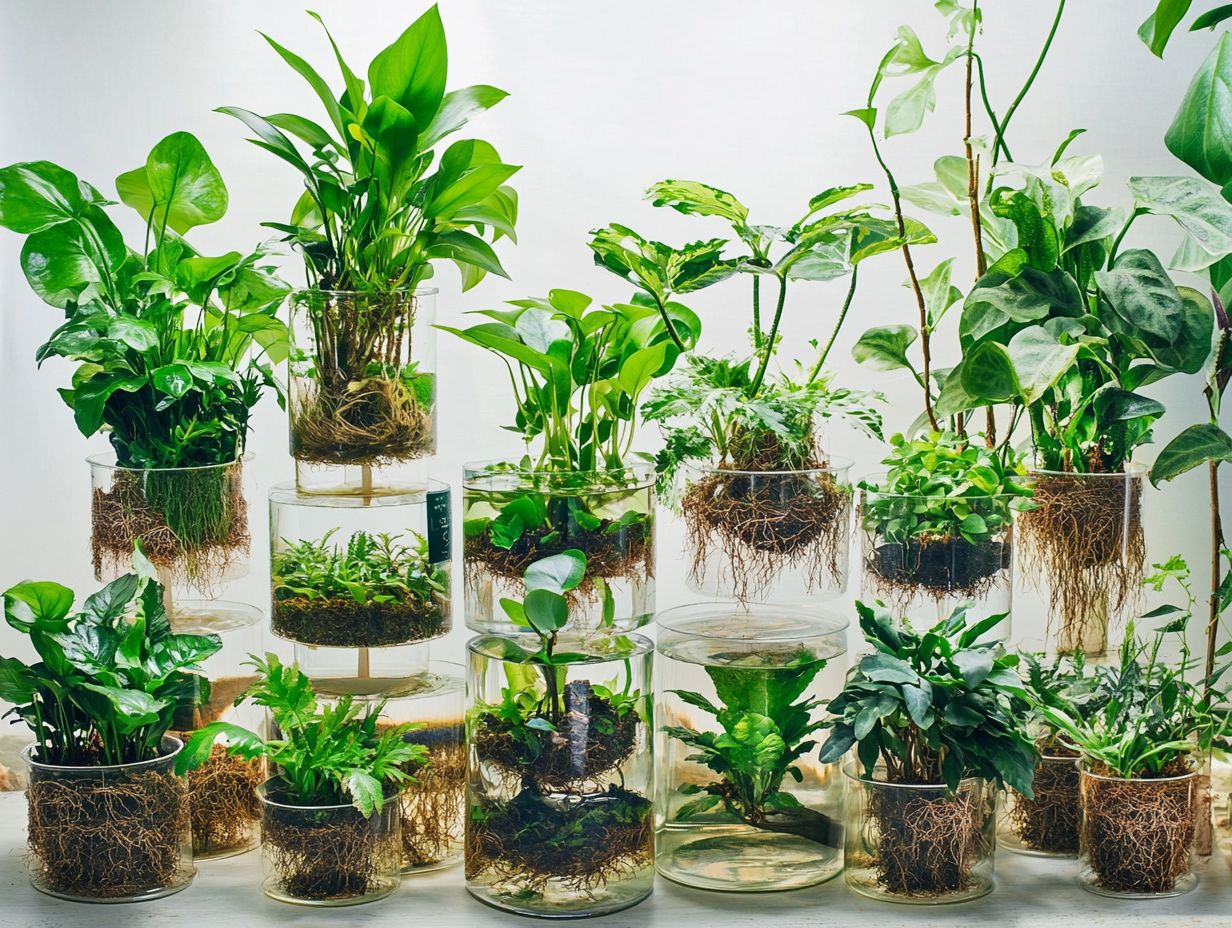
Division propagation is a method where you separate a mature plant into smaller sections, each capable of growing into a new plant. This technique is popular among gardeners because it helps maintain the plant family and ensures each section has access to nutrient-rich potting soil to support healthy root development.
Timing is key for successful division. Aim for early spring or fall when your plants are either actively growing or winding down for dormancy. Using sharp tools for clean cuts minimizes stress and damage to both the parent plant and the new sections.
After separating them, proper care is crucial. Watering and placing the divisions in suitable light conditions will encourage their growth. This method revitalizes the original plant and allows you to cultivate multiple new specimens, maximizing your gardening potential.
Choosing the Right Plants for Propagation
Selecting the right plants for propagation is essential for achieving successful outcomes and elevating your indoor gardening experience. Choosing the right plants makes your gardening journey exciting and lush!
Consider factors such as plant varieties, growth stages, and their adaptability to various propagation methods. This preparation sets the stage for a truly fruitful endeavor.
Factors to Consider
When selecting plants for propagation, there are several crucial factors to consider to ensure a rewarding experience, especially if you’re a beginner eager to cultivate your indoor jungle. Understanding each plant’s care requirements, growth habits, and propagation potential can greatly enhance your gardening techniques and success.
One primary element to examine is the light requirements of the plants. Their growth can vary significantly in different lighting conditions. The type of soil you choose also plays a critical role. While some plants thrive in well-draining mixes, others prefer moisture-retentive substrates.
Growth patterns will influence when and how to propagate effectively. Beginners often propagate plants at the wrong time of year or underestimate the importance of humidity levels, which can impede their efforts. To sidestep these common pitfalls, gather specific care guides and closely observe how plants behave in their natural environments. Utilizing effective propagation techniques for indoor plants can also enhance your success.
Supplies and Tools Needed for Indoor Plant Propagation
Equipping yourself with the right supplies and tools is crucial for success in indoor plant propagation. It makes the process both easier and more effective.
Essential items include:
- A sharp cutting knife or kitchen scissors for precise cuts,
- Rooting hormone to stimulate robust root development,
- Suitable containers designed to nurture new growth.
Ready to grow your indoor garden? Let s get started!
Essential Items for Successful Propagation
To ensure successful propagation, you ll need a few essential items: a suitable growth container, quality potting soil, and the right tools to help your plants develop healthy roots.
These components work in harmony to create the optimal environment for your new thriving plants.
The ideal growth container can be anything from seed trays to pots, designed to provide good drainage and ample space for root expansion.
Quality potting soil is paramount; it should be rich in organic matter and nutrients, fostering strong root growth while retaining moisture without becoming waterlogged.
Don t overlook the tools either pruning shears and watering cans are essential. They help you manage the various growth stages of your plants and maintain the perfect moisture levels.
Together, these elements play a critical role in nurturing young plants, ensuring they develop into robust, healthy specimens that are ready to flourish in their new environment.
Step-by-Step Guide to Indoor Plant Propagation
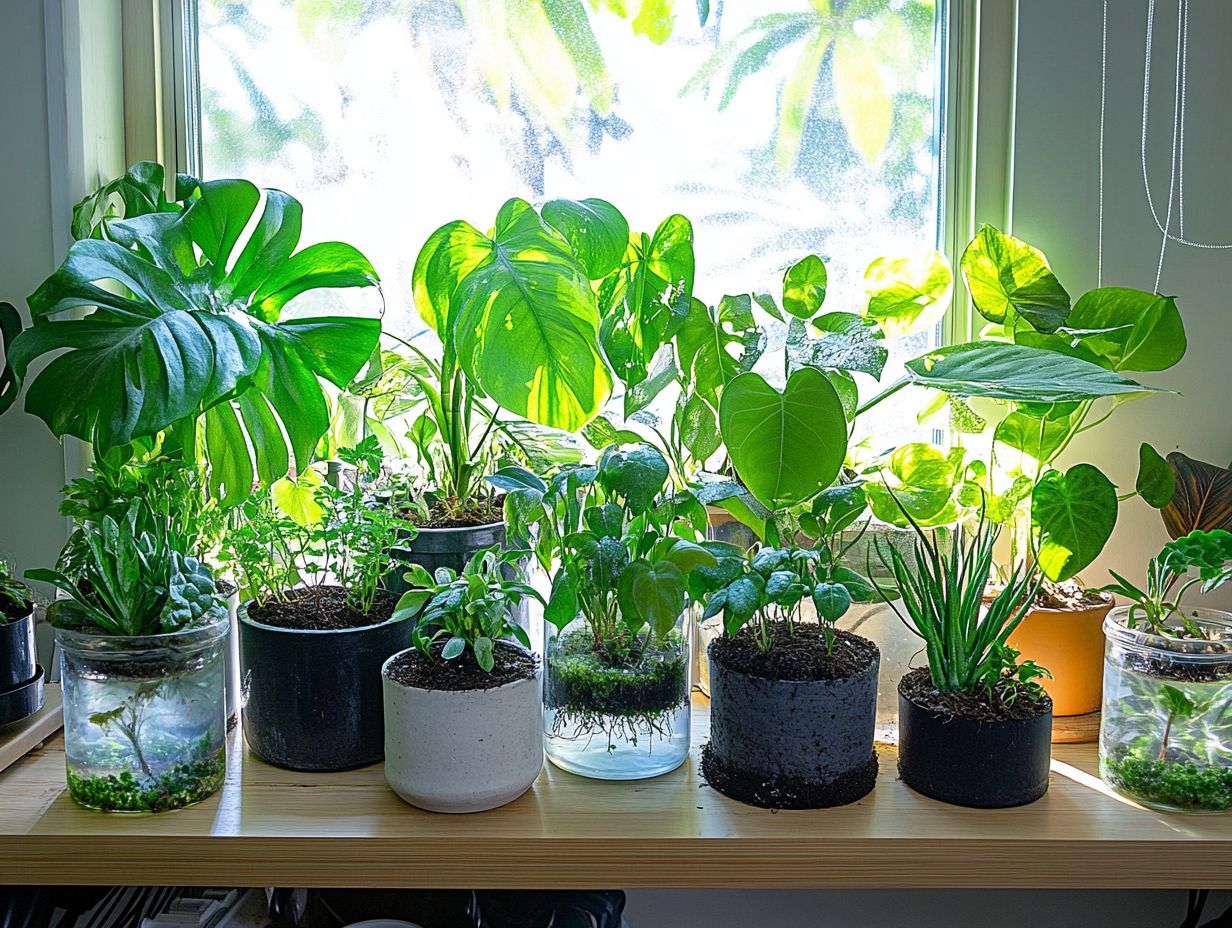
This step-by-step guide to indoor plant propagation will expertly guide you through the essential processes required to nurture your plants from cuttings, seeds, or divisions into flourishing houseplants.
As you progress, you’ll acquire valuable plant care tips, such as using a cutting knife for precise incisions that will enrich your knowledge.
A proper understanding of each stage will elevate your gardening journey filled with nurturing experiences, transforming it into a rewarding and enlightening experience.
Preparing the Plant
Preparing your plant for propagation is a key step that needs careful cutting techniques to ensure optimal success through effective propagation methods.
Focusing on nodes is necessary for creating robust new plants, and aerial roots are critical for effective cutting techniques to maximize growth potential.
Handle the plant gently during this process to prevent damage and promote healthy development of your propagating plants in your new cuttings.
Understanding plant anatomy can significantly enhance your propagation efforts; knowing exactly where to cut can lead to stronger, more resilient plants that thrive in your indoor jungle.
It s advisable to use clean, sharp tools, like kitchen scissors, for making precise incisions, ensuring cuts are made at a 45-degree angle.
This method increases the surface area for water uptake. Using rooting hormone enhances rooting efficiency.
Consider using a rooting hormone to expedite the growth process, but apply it sparingly to avoid overwhelming your cutting.
Keeping the cuttings in a humid environment, ideal for soil rooting and water rooting is crucial during their recovery, as moisture is vital.
A gentle misting helps create the ideal conditions for thriving new roots.
Creating the Propagation Environment
Creating the perfect environment for propagation is exciting and essential! You ll need conditions such as indirect light, which is essential for your plants’ growth stage that varies depending on the plant family.
Filtered water helps maintain healthy roots, which are fundamental for lush foliage and reduces root rot. You also need to set the appropriate growth stage for thriving new plants.
Striking the perfect balance among these factors is essential. For instance, indirect light encourages slow and steady growth, minimizing the risk of stretching, while filtered water shields those delicate roots from harmful chemicals.
Maintaining a stable temperature is key for a successful propagation experience; it ensures consistent metabolic activity, fostering robust root systems.
By prioritizing these conditions, you can significantly enhance root establishment and can be aided by using heat mats, ensuring that your new plants not only survive but truly flourish.
This nurturing atmosphere fundamentally supports the initial stages of growth, ultimately shaping the health and vitality of your plants.
Get started on your propagation journey today and watch your indoor garden flourish!
Caring for the New Plants
Caring for new plants during their initial growth stages is crucial for cultivating healthy roots and lush foliage. This involves adhering to specific watering guidelines and keeping an eye out for any signs of root rot. The proper care you provide at this stage greatly boosts your chances of successful propagation.
First and foremost, understand your plants’ unique needs to keep them thriving. Soil moisture management is crucial to prevent root rot. Overwatering can cause serious problems, such as root rot. Aim for consistent, yet moderate watering that allows the roots to breathe while ensuring the plant remains adequately hydrated. Adding a balanced fertilizer like Epsoma Organic during the growing period can also supply young plants with the essential nutrients they need to flourish.
Regularly observing your plants is essential. Changes like leaf discoloration can indicate nutrient deficiencies or drooping leaves can be a sign of insufficient light or water. By implementing effective drainage methods and selecting the right pots, you can reduce the risk of root rot, laying a strong foundation for vibrant growth.
Troubleshooting Common Issues
Troubleshooting common issues during propagation is crucial for any plant enthusiast like yourself. It allows you to identify and tackle problems such as root rot or insufficient growth with confidence and precision.
Understanding these challenges and incorporating effective plant care tips can significantly boost your propagation success and ensure that your indoor jungle flourishes beautifully.
Identifying and Addressing Problems
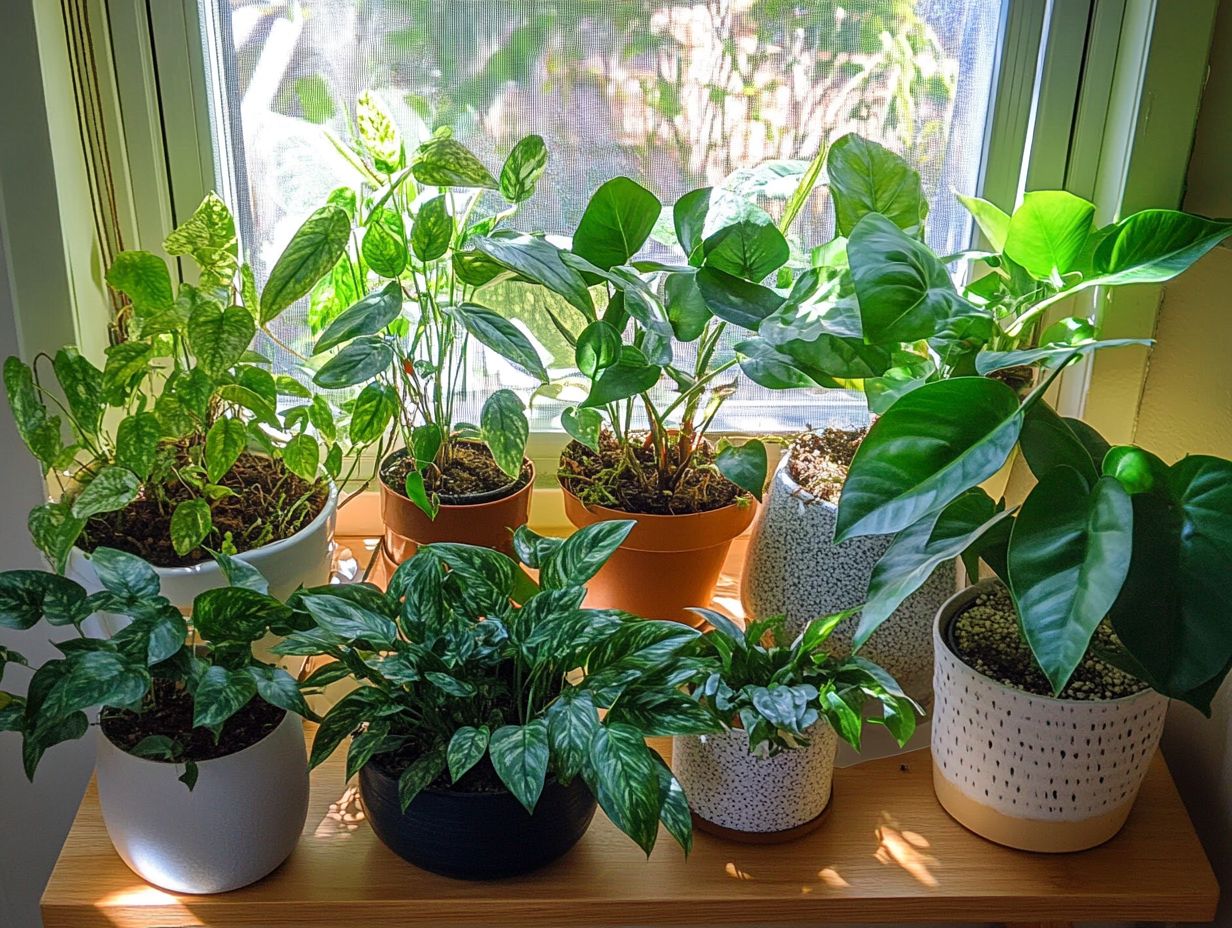
Identifying and addressing problems early in the propagation process is essential for maintaining the health of your new plants. A proactive approach helps your houseplants thrive. This allows you to effectively tackle issues like root rot or nutrient deficiency, transforming your propagation experience into a more successful endeavor.
For instance, recognizing the early signs of root rot may include observing yellowing leaves, detecting a foul odor from the soil, or noticing a mushy texture in the roots. On the other hand, nutrient deficiency might reveal itself through stunted growth or a noticeable change in leaf coloration. It s vital to regularly inspect your plants to stay ahead of these challenges.
Ensuring proper drainage in pots, using a balanced fertilizer, and fine-tuning your watering schedules can significantly enhance your ongoing plant care. Stay vigilant and proactive. Nurturing your new plants can be a rewarding journey, not a source of stress.
Frequently Asked Questions
What is indoor plant propagation, and why is it important?
Indoor plant propagation is the process of creating new plants from existing ones, using various methods such as seed germination, division, stem cutting, or leaf cutting. It allows plant lovers to expand their greenery collection and save money on buying new plants.
What are the benefits of propagating indoor plants?
There are multiple benefits to propagating indoor plants, including the ability to control the growth and health of your plants, creating new plants for free, and maintaining a sustainable and eco-friendly garden.
What are the essential tools and materials needed for indoor plant propagation?
The necessary tools and materials for indoor plant propagation include sterile pots or containers, potting soil, a watering can, scissors or pruners, rooting hormone, and a spray bottle for misting.
What are the different methods of indoor plant propagation?
Common methods of indoor plant propagation include seed germination, division, stem cutting, and leaf cutting. Each method works best for specific plants.
How can I ensure successful indoor plant propagation?
To achieve thriving indoor plants, pick a vibrant, mature specimen for propagation! Use clean tools and follow the techniques for your chosen method.
What are some common mistakes to avoid when propagating indoor plants?
Avoid using dirty tools or materials. Don’t over-water, under-water, or neglect light and humidity needs.

